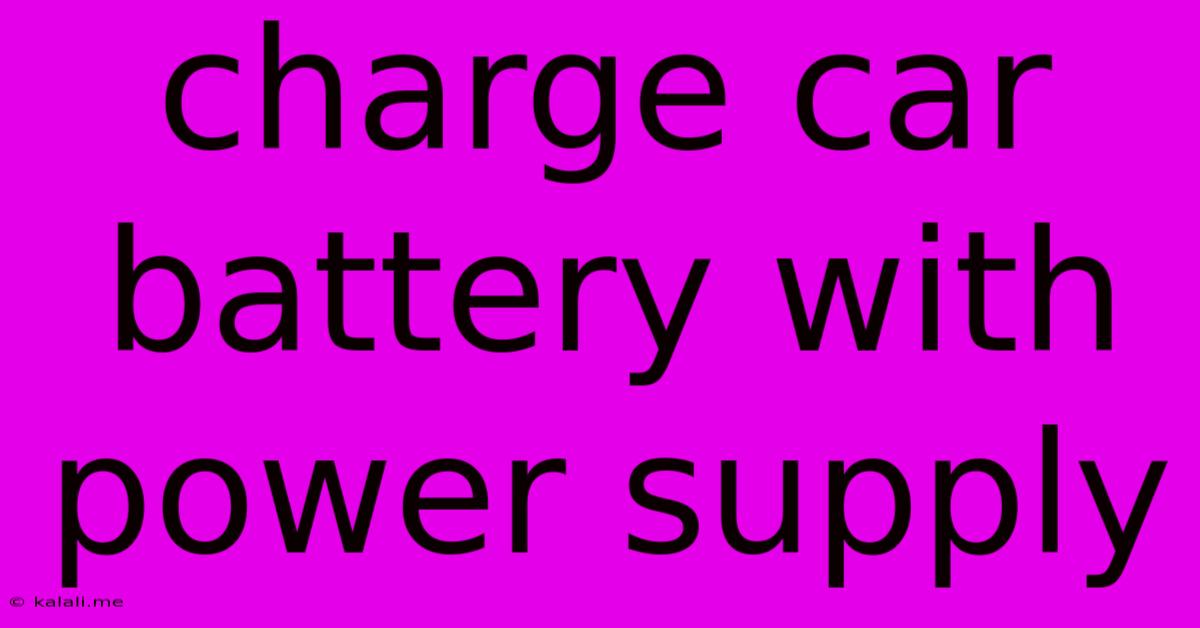Charge Car Battery With Power Supply
Kalali
Jun 07, 2025 · 3 min read

Table of Contents
Charging Your Car Battery with a Power Supply: A Comprehensive Guide
Meta Description: Learn how to safely and effectively charge your car battery using a power supply. This guide covers voltage, amperage, and crucial safety precautions to avoid damage to your battery or injury to yourself.
A dead car battery is a frustrating experience, leaving you stranded and inconvenienced. While a jump start is a quick fix for immediate needs, understanding how to charge your car battery with a power supply offers a more controlled and thorough method for restoring its health. This guide explains the process, safety measures, and important considerations for successfully charging your car battery using a power supply. This method is particularly useful for those who prefer a more hands-on approach or lack access to a traditional battery charger.
Understanding the Basics: Voltage and Amperage
Before you begin, it's crucial to understand the voltage and amperage requirements. Car batteries typically operate at 12 volts. Your power supply must match this voltage. Attempting to charge a 12-volt battery with a different voltage can severely damage it or even cause explosions.
Amperage, on the other hand, refers to the rate of charge. While a higher amperage might seem faster, it's essential to choose a power supply with an appropriate amperage to avoid damaging the battery. A lower amperage will charge slower but is generally safer. Many car batteries will have a recommended charging amperage printed on the battery case; always consult this information before proceeding. A safe starting point is often around 2-5 amps for a standard car battery. Using too high of an amperage could lead to overheating, electrolyte boiling, and potential damage.
Essential Equipment and Safety Precautions
Before you start charging your battery, gather the necessary equipment and understand the safety precautions:
- Power Supply: A regulated DC power supply capable of outputting 12 volts at the appropriate amperage.
- Multimeter: To monitor the voltage during the charging process. This is highly recommended for safety and to ensure proper charging.
- Battery Terminals: Ensure they are clean and free of corrosion. Use a wire brush or battery terminal cleaner to remove any build-up.
- Connecting Cables: Use appropriately sized and insulated cables to connect the power supply to the battery terminals.
- Safety Glasses: Protect your eyes from potential sparks or splashes.
- Gloves: Protect your hands from acid.
- Well-ventilated area: Battery charging can produce flammable gases.
Warning: Always disconnect the negative terminal (-) first when working on the battery and reconnect it last. This minimizes the risk of short circuits and accidental sparks.
The Charging Process: Step-by-Step Guide
- Prepare the Battery: Clean the battery terminals thoroughly.
- Set the Power Supply: Adjust the power supply to output 12 volts at your chosen amperage (remember to consult the battery's recommendations).
- Connect the Cables: Connect the positive (+) cable from the power supply to the positive (+) terminal of the battery. Then, connect the negative (-) cable from the power supply to the negative (-) terminal of the battery. Ensure secure connections to avoid arcing.
- Monitor the Voltage: Use the multimeter to regularly check the battery voltage during charging. The voltage should gradually increase. Never allow the voltage to exceed 14.4 volts.
- Charging Time: The charging time will vary depending on the battery's capacity and the amperage used. It could take several hours, or even overnight for a completely discharged battery. Regularly monitor the battery and the charging process.
- Disconnecting: Once the battery reaches full charge (typically around 13.5-14.0 volts), disconnect the negative (-) cable first, followed by the positive (+) cable.
Troubleshooting Common Issues
- Battery not charging: Check all connections, ensure the power supply is functioning correctly, and verify the voltage output.
- Overheating: Reduce the amperage setting on the power supply.
- Low Voltage After Charging: The battery might be damaged and require replacement.
Charging a car battery with a power supply requires care and attention to detail. By following these guidelines and prioritizing safety, you can effectively restore your car battery and get back on the road. Remember, if you are unsure about any aspect of this process, it is always best to consult a qualified mechanic.
Latest Posts
Latest Posts
-
Poor Wifi Reception On My Android
Jun 07, 2025
-
How To Turn Up Temp On Hot Water Heater
Jun 07, 2025
-
How To Remove Screen Door From Sliding Doors
Jun 07, 2025
-
Cubic Feet Per Second To Feet Per Second
Jun 07, 2025
-
Dexter Does Way More For The Police
Jun 07, 2025
Related Post
Thank you for visiting our website which covers about Charge Car Battery With Power Supply . We hope the information provided has been useful to you. Feel free to contact us if you have any questions or need further assistance. See you next time and don't miss to bookmark.